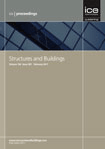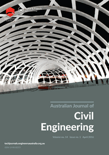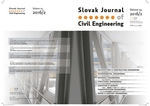
PROCEEDINGS OF THE INSTITUTION OF CIVIL ENGINEERS-STRUCTURES AND BUILDINGS
Scope & Guideline
Advancing the Future of Civil Engineering
Introduction
Aims and Scopes
- Structural Performance and Analysis:
The journal emphasizes research on the structural performance of various materials and systems under different loading conditions, including static, dynamic, and seismic loads. - Innovative Materials and Techniques:
It explores new materials such as fiber-reinforced polymers, geopolymer concrete, and sustainable materials, along with innovative construction techniques that improve structural integrity and sustainability. - Safety and Reliability Assessments:
Research on the safety, reliability, and resilience of structures against hazards such as earthquakes, explosions, and fire is a key focus area, contributing to better design practices. - Computational Modelling and Simulation:
The journal publishes studies utilizing advanced computational methods, including finite element analysis, machine learning, and neural networks, to predict structural behavior and optimize designs. - Sustainable and Resilient Design:
There is a strong emphasis on sustainable engineering practices, including energy-efficient designs, the use of recycled materials, and the development of structures that can withstand environmental challenges. - Field Studies and Experimental Research:
The journal encourages empirical research through field studies and laboratory experiments that validate theoretical models and contribute to the practical application of engineering principles.
Trending and Emerging
- Smart Structures and Monitoring Technologies:
An increasing number of publications focus on the integration of smart technologies, such as sensors and IoT devices, for real-time monitoring of structural health and performance. - Resilience and Sustainability in Design:
There is a growing trend towards designing structures that are not only resilient to hazards but also sustainable, with an emphasis on reducing carbon footprints and utilizing eco-friendly materials. - Advanced Computational Techniques:
The use of advanced computational techniques, including machine learning and artificial intelligence for predictive modeling and optimization, is gaining traction in the journal's publications. - Multi-Hazard Assessment:
Research addressing the performance of structures under multiple hazards, including earthquakes, blasts, and fires, is increasingly prevalent, reflecting the complexity of modern engineering challenges. - Behavior of Novel Materials:
Emerging research focuses on understanding the behavior of new materials, such as high-performance concrete and fiber-reinforced composites, under various environmental and loading conditions. - Seismic Retrofit and Strengthening Techniques:
There is a noticeable increase in studies dedicated to retrofitting and strengthening existing structures, particularly in seismically active regions, to enhance their resilience.
Declining or Waning
- Traditional Materials and Construction Methods:
Research focused on conventional materials and construction practices has decreased, possibly due to the growing interest in innovative materials and sustainable design approaches. - Basic Structural Analysis:
The frequency of papers solely addressing basic structural analysis without the application of advanced computational techniques or innovative materials has diminished. - Static Load Analysis:
There is a noticeable decline in research centered around static load analysis, as more emphasis is placed on dynamic and multi-hazard assessments reflecting real-world conditions. - Non-empirical Studies:
The journal has seen a reduction in non-empirical studies that do not incorporate experimental validation, as there is a growing preference for research that is grounded in practical applications. - General Design Guidelines:
Papers that focus on general design guidelines without specific innovative contributions or case studies have become less common, indicating a shift toward more specialized research.
Similar Journals

Journal of Structural Integrity and Maintenance
Advancing the Future of Structural Integrity and MaintenanceThe Journal of Structural Integrity and Maintenance, published by Taylor & Francis Ltd, serves as a prestigious platform dedicated to the advancement of knowledge in the fields of structural integrity, civil engineering, and materials science. With an ISSN of 2470-5314 and an E-ISSN of 2470-5322, this journal is uniquely positioned to address the critical challenges faced by researchers and professionals in building and construction, mechanical engineering, and related domains. Since its inception in 2016, this journal has been consistently recognized for its quality, currently holding a Q2 rank across several disciplines, including Building and Construction and Civil and Structural Engineering in 2023. The journal aims to publish high-quality research that contributes to the understanding and maintenance of structural integrity, fostering innovations that promote safety, efficiency, and sustainability in engineering practices. Researchers and students alike are encouraged to engage with this rich repository of knowledge, which plays a vital role in shaping future advancements in structural engineering and materials science.

Revista Ingenieria de Construccion
Exploring the Intersection of Theory and Practice in ConstructionRevista Ingenieria de Construccion is a prominent open-access journal dedicated to advancing knowledge and practice in the fields of building and construction engineering, as well as civil and structural engineering. Published by the Pontificia Universidad Católica de Chile, specifically the Department of Engineering and Construction Management, this journal has been providing free access to quality research outputs since 1986, ensuring that vital information is available to both practitioners and academics globally. With its current placement in the Q4 category of both the Building and Construction and Civil and Structural Engineering quartiles, it serves as a platform for innovative studies and critical discussions, positioning itself strategically within the academic landscape. The journal is indexed in Scopus, ranking #157 in Building and Construction and #291 in Civil and Structural Engineering, reflecting the growing impact and relevance of its contributions. Researchers, professionals, and students are encouraged to engage with the rigorous and diverse content published within its pages, fostering a vibrant academic and practical discourse.

International Journal of Structural Integrity
Fostering Interdisciplinary Insights in Structural IntegrityInternational Journal of Structural Integrity is a premier peer-reviewed academic journal published by EMERALD GROUP PUBLISHING LTD in the United Kingdom. As a valuable resource in the fields of Civil and Structural Engineering, Mechanical Engineering, and Mechanics of Materials, this journal serves to advance knowledge and foster innovation in these critical areas of study. With an impressive impact factor reflected in its 2023 category quartiles, ranking Q2 across multiple engineering disciplines, the journal is recognized for its contributions to research and practical application. Researchers can benefit from its rigorous publishing standards that encompass a wide array of interdisciplinary topics pertaining to structural integrity. Accessing the journal is facilitated for those seeking high-quality research and findings, vital to both academia and industry. Since its inception in 2010 and extending until 2024, the journal continues to attract scholarly articles that push the boundaries of engineering knowledge, making it an essential platform for professionals, students, and researchers seeking to stay at the forefront of structural engineering."

Advanced Steel Construction
Fostering Collaboration in Steel Research and DevelopmentAdvanced Steel Construction is a prominent journal published by the Hong Kong Institute of Steel Construction, dedicated to the field of structural engineering and material sciences with a specific focus on steel construction techniques and advancements. Since its inception in 2005, the journal has established itself as a valuable resource for researchers, professionals, and students alike, offering insights into the latest developments and innovative practices within the realms of building construction, civil engineering, and materials mechanics. With its recognition as a Q2 journal across multiple engineering categories, including Building and Construction, Civil and Structural Engineering, Mechanical Engineering, and Mechanics of Materials, it ranks competitively in Scopus rankings, highlighting its significance in academic discourse. The journal is based in China, at the Hong Kong Polytechnic University, and provides an essential platform for sharing groundbreaking research and fostering collaboration within the engineering community.

Magazine of Civil Engineering
Showcasing Excellence in Civil Engineering ScholarshipMagazine of Civil Engineering, published by ST-PETERSBURG STATE POLYTECHNICAL UNIVERSITY, is a prominent open access journal dedicated to the field of civil and structural engineering. With an ISSN of 2712-8172 and E-ISSN 2071-0305, it serves as a vital platform for disseminating high-quality research, innovative methodologies, and current trends in building and construction. Since its inception in 2010, the journal has embraced open access, ensuring broad visibility and accessibility for its contributions to the academic community. The magazine holds a respectable position in the academic hierarchy, ranked in the Q3 quartile for both Building and Construction and Civil and Structural Engineering categories as of 2023. It is indexed in Scopus, amplifying its societal impact and reach with a rank of #114/223 in Building and Construction and #224/379 in Civil and Structural Engineering. Researchers, professionals, and students alike are encouraged to engage with the cutting-edge studies presented in the magazine, contributing to the advancement of knowledge and practice within the civil engineering domain.

Australian Journal of Civil Engineering
Shaping the Landscape of Civil Engineering KnowledgeThe Australian Journal of Civil Engineering, published by Taylor & Francis Ltd, stands as a pivotal platform within the field of civil and structural engineering. With an ISSN of 1448-8353 and an E-ISSN of 2204-2245, this journal consistently delivers high-quality research and innovative practices from both established and emerging scholars in the discipline. Recognized in the Q2 category for Civil and Structural Engineering in 2023, it holds a respectable position, ranking 146 out of 379 within its field according to Scopus, which places it in the 61st percentile. Converging valuable insights from 2011 through 2024, the journal encompasses a broad scope of topics, including sustainable infrastructure, innovative materials, and advanced construction techniques, thereby addressing contemporary challenges faced by engineering professionals. Though it is a traditional publication without open access options, the quality of the research featured ensures that it remains an essential resource for academics, practitioners, and students striving to enhance their knowledge and contribute to the dynamic field of civil engineering.

Journal of Building Engineering
Advancing the Future of Building EngineeringWelcome to the Journal of Building Engineering, a premier platform for the dissemination of innovative research in the fields of Architecture, Building and Construction, Civil and Structural Engineering, Mechanics of Materials, and Safety, Risk, Reliability and Quality. Published by ELSEVIER and based in the Netherlands, this journal has solidified its reputation as a leader in the field, proudly achieving a prestigious Q1 ranking across multiple categories as of 2023. With a remarkable impact in Scopus, including being ranked #1 in Architecture and consistently placing within the top 20 in other critical disciplines, the journal is dedicated to fostering high-quality research that addresses contemporary challenges in building technology and engineering practices. The E-ISSN 2352-7102 further facilitates access to groundbreaking articles from 2015 to 2024, making it a vital resource for researchers, industry professionals, and students alike. Embrace the opportunity to engage with cutting-edge studies that not only contribute to academic dialogue but also influence practical applications in the rapidly evolving landscape of building engineering.

Structural Concrete
Leading the Way in Concrete Material InnovationsStructural Concrete, published by ERNST & SOHN, is a premier journal dedicated to the field of Civil and Structural Engineering, focusing on innovative research and advancements in concrete materials and technologies. With an impressive impact factor and a consistent ranking in the Q1 category of both Building and Construction and Civil and Structural Engineering, the journal stands as a vital resource for researchers, professionals, and students alike. It is indexed with notable Scopus ranks, underscoring its significance within the academic community. The journal spans a comprehensive scope (from 2001 to the present) that encompasses diverse topics related to the behavior, design, and application of structural concrete. Although not an open access publication, it offers valuable insights and cutting-edge knowledge that contribute to the ongoing evolution of construction practices and materials science. Structural Concrete is an essential platform for sharing pioneering findings and fostering collaboration within this dynamic field.

Slovak Journal of Civil Engineering
Exploring groundbreaking solutions in civil engineering.Welcome to the Slovak Journal of Civil Engineering, a premier open-access publication dedicated to advancing the field of civil engineering. Published by SCIENDO, this journal has been providing a platform for the dissemination of groundbreaking research since 2010, ensuring that all articles are freely accessible to a global audience. With a commitment to promoting innovation and excellence within civil engineering, the journal covers a wide range of topics, including structural engineering, transportation systems, geotechnics, and environmental engineering. The Slovak Journal of Civil Engineering is designed to engage a diverse community of researchers, professionals, and students, fostering collaboration and knowledge-sharing to address contemporary challenges in the field. With its open-access model, the journal not only enhances visibility for authors but also ensures that the latest findings and methodologies reach practitioners and academics alike, making it an essential resource for anyone interested in civil engineering advancements. Stay connected with the evolving landscape of civil engineering through this influential publication.

Periodica Polytechnica-Civil Engineering
Championing Quality Research in Civil and Structural EngineeringPeriodica Polytechnica-Civil Engineering is a prestigious journal published by the Budapest University of Technology and Economics, dedicated to advancing the field of civil engineering through high-quality research and innovative practices. Established in 1972, the journal has transitioned through various phases of publication and now spans an expansive range of topics within civil and structural engineering, geotechnical engineering, and engineering geology. With an impact factor indicating its growing influence and a commendable placement in the Q3 quartile according to the latest 2023 metrics, it recognizes contributions that bridge theoretical advancements with practical applications. While currently not open access, the journal remains a vital resource for researchers, professionals, and students seeking to stay abreast of the latest developments in engineering design, construction techniques, and geotechnical innovations. The continuous publication of significant research after almost five decades underscores its commitment to disseminating knowledge crucial for the world’s infrastructure challenges, making it an essential reference point within the engineering community.